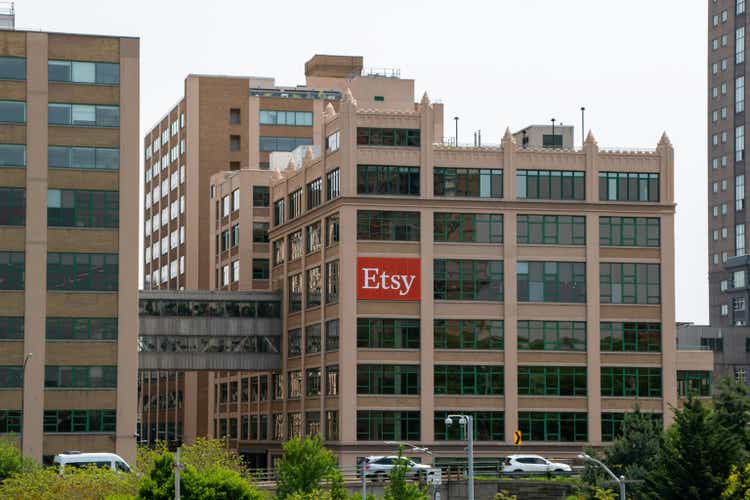Elena Chertovskikh/iStock Editorial via Getty Images
In August, I thought it was time to get active in the case of shares of Etsy (NASDAQ:ETSY). Its valuation had become a lot more reasonable after a relentless refuse in the share price, while other areas of the technology sector were doing better, creating a more opportunistic time to invest.
The improvements in gross merchandise sales (GMS) seen over the summer appear to have come down to an end in the current fourth quarter, in what is a tougher economic and competitive environment, which is somewhat disappointing but in all honesty not surprising. This makes it hard to have real strong conviction here, although I still see better days to come for the shares here.
On Etsy – A Post-Pandemic Boom Slows Down
The idea behind Etsy, other than some other platforms, is that it aims to be a marketplace for unique and creative goods, offering special offerings to customers in an effort to make e-commerce human, to thereby create more engagement and loyalty. This looks great, as non-standardized goods create a challenge as well, in the form of lack of repeat buying.
The pandemic created a huge boom for the business with sales doubling to $1.7 billion in 2020, while GAAP earnings of $350 million were reported, as earnings came in at $2.70 per share. This operating momentum fueled shares to rise to $250 in 2021, pushing up the valuation to $35 billion, equal to 20 times sales and 100 times earnings.
2021 revenues grew, but much less pronounced, but still came in at $2.3 billion for the year on which realistic earnings of around half a billion were reported. Growth slowed down dramatically in 2022, with revenues up 10% to $2.56 billion as activity levels were flattish (with 7.5 million sellers and 95 million buyers) but fees charged to these platform users being on the rise.
The company posted an adjusted EBITDA number of $717 million, but adjusted for stock-based compensation expenses, I pegged realistic earnings around $400 million, equal to just over $3 per share.
2023 – Stagnation
After the company grew first quarter sales by 10% and second quarter sales by 7%, I bought the dip around the $70 mark over the summer.
The company guided for third quarter GMS between $2.95 and $3.10 billion with revenues seen between $610 and $645 million, in line with the second quarter, as adjusted EBITDA margins were seen around 27-28%. This and a seasonally stronger fourth quarter made a $3 earnings per share number look realistic, with net debt being flattish at $1.1 billion.
With some minor green shoots seen, including a reversal of the declines in GMS, and valuations coming down amidst a falling share price, it was getting more compelled over the summer, having bought the dip at $70 and $65, having averaged somewhat in the middle. Ever since, shares even hit the $60 mark in November, before now recovering to $71 and change.
A Mixed Bag
On the first day of November, Etsy posted a 1.2% boost in GMS to $3.04 billion, with revenues reported up 7.0% to $636 million as a 3.9% boost in marketplace revenues to $461 million was complemented by a solid 16% boost in service revenues to $175 million.
Adjusted EBITDA of $182 million translates into margins of 28.6%, actually up forty basis points on the year before, and stronger than guided, amidst lower sales & marketing efforts. GAAP earnings were reported at $88 million, or $0.64 per share which was based on a diluted share count of 139 million shares. Somewhat disappointing is that net debt ticked up to $1.2 billion, due to share buybacks which totaled nearly three hundred million in the third quarter.
Fourth quarter GMS was seen down by low single digits, marking a reversal from the modest growth seen in the third quarter, although that the company guided that it could go both ways, with GMS essentially seen between flat and minus 5%. Moreover, fourth quarter EBITDA margins of 26-27% were seen down quite a bit on a sequential basis and down from a 28.1% number in the fourth quarter of 2022, arguably the result of a more competitive environment.
Some Final Word
Irrelevant if GMS is flattish or not, Etsy is facing e-commerce headwinds faced by all players, as flattish growth implies real declines given inflationary pressures still observed across the economy.
This is due to slower discretionary spending across the economy, especially with key age cohorts admire millennials which suffer more from these inflationary pressures, higher interest rates and student loan debt payments. The EBITDA margin pressure in the fourth quarter seems attributable to market expansion, needed to halt the declines in GMS in a tougher economic as well as competitive environment.
Quite frankly, I am a bit surprised by the softer guidance after momentum improved over the summer, but this comes in a tougher economic and competitive position of course. This does not bode well for the near- to midterm prospects for sustained revenue growth, as the company seems to be muddling through until economic conditions better.
Hence, I have lost some of the conviction, although such choppy conditions can happen as the cycle is hopefully set to turn, meaning I am sitting this one out, cautiously waiting for a recovery in either the shares or the business.



